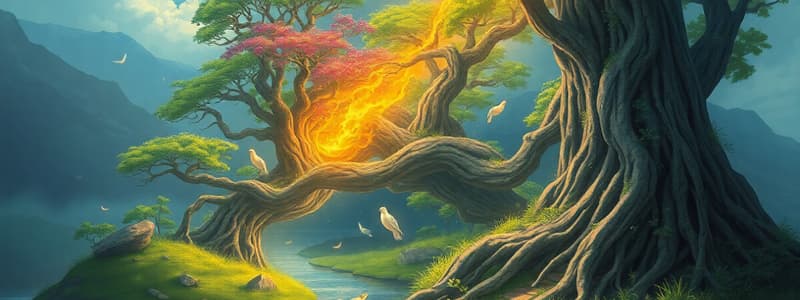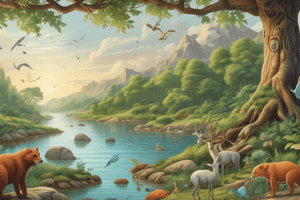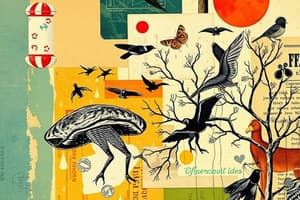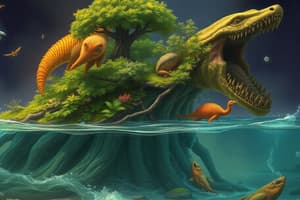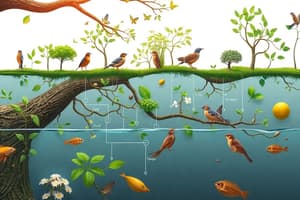Podcast
Questions and Answers
Which of the following organisms is considered a producer?
Which of the following organisms is considered a producer?
- Weasel
- Hawk
- Red squirrel
- Green algae (correct)
Carnivores are organisms that eat both producers and consumers.
Carnivores are organisms that eat both producers and consumers.
False (B)
What is the role of decomposers in an ecosystem?
What is the role of decomposers in an ecosystem?
Decomposers break down dead or decaying organisms to recycle nutrients.
The relationship between a predator and its prey can be seen when an ______ eats a trout.
The relationship between a predator and its prey can be seen when an ______ eats a trout.
Match the following types of consumers with their definitions:
Match the following types of consumers with their definitions:
In a food chain, how is energy represented?
In a food chain, how is energy represented?
All consumers depend solely on photosynthesis for their energy.
All consumers depend solely on photosynthesis for their energy.
Name an example of an omnivore.
Name an example of an omnivore.
Seeds from a pine tree are an example of a ______.
Seeds from a pine tree are an example of a ______.
What describes the main function of photosynthesis?
What describes the main function of photosynthesis?
Which trophic level contains producers?
Which trophic level contains producers?
Secondary consumers are herbivores.
Secondary consumers are herbivores.
What percentage of energy is typically passed on to the next trophic level?
What percentage of energy is typically passed on to the next trophic level?
Pollinators are essential for the ______ of plants.
Pollinators are essential for the ______ of plants.
Match the following trophic levels with their consumers:
Match the following trophic levels with their consumers:
What can disrupt a food chain?
What can disrupt a food chain?
Food webs provide a complete model of feeding relationships compared to food chains.
Food webs provide a complete model of feeding relationships compared to food chains.
Name one function of pollination.
Name one function of pollination.
The ______ crayfish invades ecosystems and competes with native species.
The ______ crayfish invades ecosystems and competes with native species.
Which of the following fruits is NOT typically a result of pollination?
Which of the following fruits is NOT typically a result of pollination?
Which trophic level primarily consists of herbivores?
Which trophic level primarily consists of herbivores?
Typically, 20% of the energy taken in by organisms is passed on to the next level in a food chain.
Typically, 20% of the energy taken in by organisms is passed on to the next level in a food chain.
What role do pollinators play in the reproduction of plants?
What role do pollinators play in the reproduction of plants?
The rusty crayfish is an example of an invasive species that can disrupt a ______.
The rusty crayfish is an example of an invasive species that can disrupt a ______.
Match the following fruits with their traits:
Match the following fruits with their traits:
Which statement best describes a food web?
Which statement best describes a food web?
Fruit is formed from the ovary of a plant after fertilization of its egg cell.
Fruit is formed from the ovary of a plant after fertilization of its egg cell.
Without pollinators, plants wouldn't be able to produce ______.
Without pollinators, plants wouldn't be able to produce ______.
What is the primary function of pollen in plants?
What is the primary function of pollen in plants?
Which of the following are examples of producers?
Which of the following are examples of producers?
Carnivores only consume other animals.
Carnivores only consume other animals.
The arrow in a food chain always points to the organism that is ______.
The arrow in a food chain always points to the organism that is ______.
Which of the following is an example of a predator-prey relationship?
Which of the following is an example of a predator-prey relationship?
Energy flows in one direction through a food chain, from producers to consumers.
Energy flows in one direction through a food chain, from producers to consumers.
What is the main function of photosynthesis?
What is the main function of photosynthesis?
Energy is lost as ______ at each trophic level in a food chain.
Energy is lost as ______ at each trophic level in a food chain.
Match the following organisms with their trophic levels:
Match the following organisms with their trophic levels:
Flashcards
Producer
Producer
Organisms that produce their own food using sunlight through photosynthesis.
Consumer
Consumer
Organisms that obtain their energy by consuming other organisms.
Herbivore
Herbivore
Consumers that eat only plants or other producers.
Carnivore
Carnivore
Signup and view all the flashcards
Omnivore
Omnivore
Signup and view all the flashcards
Scavenger
Scavenger
Signup and view all the flashcards
Decomposer
Decomposer
Signup and view all the flashcards
Food Chain
Food Chain
Signup and view all the flashcards
Trophic Level
Trophic Level
Signup and view all the flashcards
Predator-Prey Relationship
Predator-Prey Relationship
Signup and view all the flashcards
Herbivores or Primary Consumers
Herbivores or Primary Consumers
Signup and view all the flashcards
Carnivores or Secondary Consumers
Carnivores or Secondary Consumers
Signup and view all the flashcards
Tertiary Consumers
Tertiary Consumers
Signup and view all the flashcards
Energy Pyramid
Energy Pyramid
Signup and view all the flashcards
Food Web
Food Web
Signup and view all the flashcards
Pollination
Pollination
Signup and view all the flashcards
Pollen
Pollen
Signup and view all the flashcards
Study Notes
Interactions in Ecosystems
- Interactions within ecosystems involve interconnected food chains and webs.
- Energy pyramids illustrate energy flow within the ecosystem.
- Ecosystems contain key organisms, producers and consumers.
Types of Organisms
- Producers create their own energy through photosynthesis (e.g., plants, algae).
- Consumers obtain energy by consuming other organisms (e.g., humans, hawks).
- Consumers can further be classified as herbivores (plant-eaters), carnivores (meat-eaters), and omnivores (plant and meat-eaters).
- Scavengers and decomposers feed on dead or decaying organisms.
Types of Consumers
- Consumers are categorized based on their diet and behavior.
- Herbivores feed on plants or other producers.
- Carnivores feed on other consumers.
- Omnivores consume both producers and consumers.
- Scavengers and decomposers feed on dead or decaying organisms.
Food Chains
- Food chains depict the transfer of energy from one organism to another.
- Illustrates feeding relationships among organisms in an ecosystem.
- Example: Pine seeds (producer) → Red squirrel (omnivore) → Weasel (carnivore) → Goshawk (carnivore).
- Arrows in a food chain show the direction of energy flow.
Food Chains (predator-prey)
- Carnivorous animals often have predator-prey relationships.
- Ex: The osprey (predator) eats the trout (prey).
Energy in the Food Chain
- Chemical energy from producers is transferred to consumers through digestion.
- Some energy is lost as heat.
- Subsequent consumers receive less energy than the previous ones.
Energy in the Food Chain (direction)
- Arrows in a food chain point to the organism doing the consuming.
Trophic Levels
- Trophic levels describe an organism's position in a food chain.
- Trophic Level 1 is composed of producers.
- Trophic Level 2 contains herbivores or primary consumers.
- Level 3 consists of carnivores or secondary consumers.
- Level 4 consists of carnivores called tertiary consumers.
Energy Pyramids
- Energy pyramids show the flow of energy through trophic levels.
- Only about 10% of energy is transferred to the next trophic level.
- Most energy is lost as heat.
Food Webs
- Food webs depict a complex network of interconnected food chains.
- Food webs show the complex feeding relationships within an ecosystem.
- A consumer feeding on many species is less affected if one population decreases or becomes scarce.
- Introduced species can disrupt food chains.
Food Web Interactions
- Invasive species can compete with native species for the same resources.
- Example: The rusty crayfish competes with native species for food.
Pollination
- Pollinators are essential for plant survival and reproduction.
- Pollination helps plants sexually reproduce.
- Pollination creates seeds and fruit.
What is Pollen?
- Pollen is plant sperm.
- Pollinators carry pollen from one plant to another, facilitating cross-pollination.
- This results in the growth of plants with traits from both parent plants.
Cross-Pollination
- Pollen from one plant is transferred to another plant.
- This involves the transfer of pollen grains from the stamen to the pistil of a different plant of the same species.
- Pollinators like bees carry pollen between different plants.
Pollinators
- Various animals act as pollinators.
- Example: Bats, bees, moths, butterflies, and hummingbirds.
Fruit
- Fruit is a swollen ovary containing seeds that can grow into new plants.
- Fruit production depends on pollination.
Fruit Examples
- This section lists various fruits (e.g., star fruit, rambutan, jackfruit, bananas, pears, mangoes, pineapples, passion fruit, mangosteen, African cucumber, durian, and tamarind).
Studying That Suits You
Use AI to generate personalized quizzes and flashcards to suit your learning preferences.
